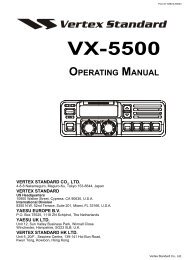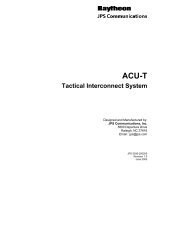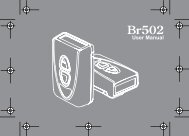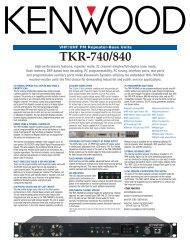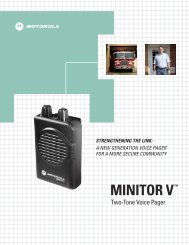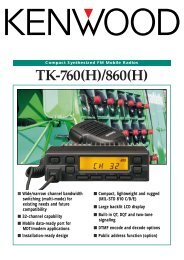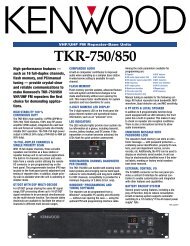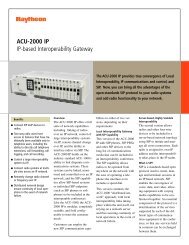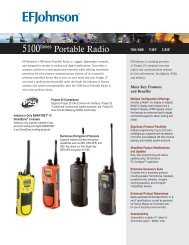DISTRIBUTED LOGIC TRUNKED RADIO SYSTEMS - Lauttamus ...
DISTRIBUTED LOGIC TRUNKED RADIO SYSTEMS - Lauttamus ...
DISTRIBUTED LOGIC TRUNKED RADIO SYSTEMS - Lauttamus ...
Create successful ePaper yourself
Turn your PDF publications into a flip-book with our unique Google optimized e-Paper software.
10Each system can be further identified by an ‘Area Bit,’ either a 1 or a 0 set into the datastream. This area bit can be used to minimize interference from neighboring systems(area bits alternated between systems with overlapping coverage) or to improve systemsecurity by complicating unauthorized airtime access.By convention, distributed logic trunking system channels are often referred to by theirbus time slot assignments as repeater channel numbers 01 through 20. However, eachRF channel frequency pair at 800 and 900 MHz uses a three-digit ‘FCC Channel Number’to designate the assigned RF frequencies (a lookup table defined by the FCC). This FCCChannel Number (1 to 911 at 800 MHz, 1 to 399 at 900 MHz) should not be confusedwith the repeater channel numbers (01 to 20) that designate the repeater number withinthe distributed logic system.To eliminate confusion, Kenwood refers to repeater numbers with two digits (belowchannel 10), appending the system’s sync master with the letter ‘M’ (example: 01M, 02,03, etc.). At 800 and 900 MHz, channel numbers are referred to by three digits (example:001, 452, 489, etc.). Although some timing advantages still remain, early systemsrequired balancing the repeater numbers (time slots used) across the 20 available. Forexample, instead of clustering a 5 channel system together as 01M, 02, 03, 04, 05, timeslot balancing uses 01M, 05, 09, 13, 17 to equalize the gaps between bus data.Kenwood continues the legacy time slot balancing as its default system setup.Early distributed logic mobiles used a periodic idle channel packet sent by all repeaters inthe trunking system every 10 seconds (during a channel’s idle periods) to all the mobilesto confirm the system’s presence. Modern radios no longer need this idle channel packetas a periodic update during idle periods and, especially in the case of shared VHF andUHF frequencies, it is often disabled as a courtesy to co-channel users. On systemswhere the idle channel packets are active, idle channel packet activity can be animportant diagnostic tool by using a radio programmed as conventional, carrier-squelchon a site’s individual channels.The FCC requires periodic identification of transmitters, either by vocally announced callsigns or by automatically transmitting the call sign in Morse code. All modern distributedlogic controllers are capable of Morse code identification (CWID) of the channel andaccommodate normal CWID hold-off to prevent end users from hearing the CWID.Identification requirements vary; at 800 and 900 MHz only the first channel in the systemis normally identified; at VHF and UHF, all channels must be identified individually.ID Codes / Validation:Distributed logic trunking systems have a system architecture maximum of 20 channelsper physical system. Each channel in a system has a maximum of 250 talkgroup IDcodes available. This means that a 20-channel system can have a maximum of 5000 IDcodes. Groups of related users (talkgroups) are assigned one of these available IDcodes. Any number of users can share the same ID code and communicate with eachother.The complete talkgroup ID is specified as being the home channel plus the individual IDwithin that channel, such as 05-221: Home channel 05, ID code 221. These IDs areoften divided into usage blocks in each controller so blocks of IDs can be designated asdispatch, other blocks as interconnect, others as paging, etc.Often, the system operator finds it advantageous to pre-assign certain ID codes assystem maintenance codes (test codes) or a product demonstration codes. This allowsmaintenance or demonstration activities to take place without impacting customer traffic.KENWOOD U.S.A. CORPORATION – COMMUNICATIONS DIVISION678-474-4700 voice 1-800-TRUNKING 678-474-4730 fax



